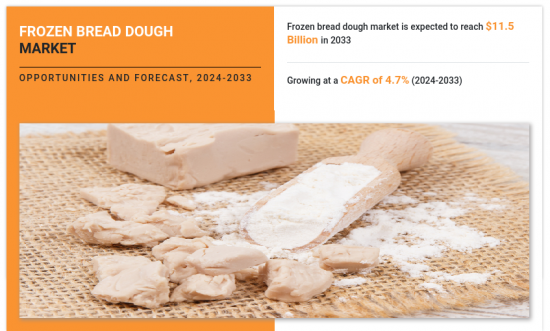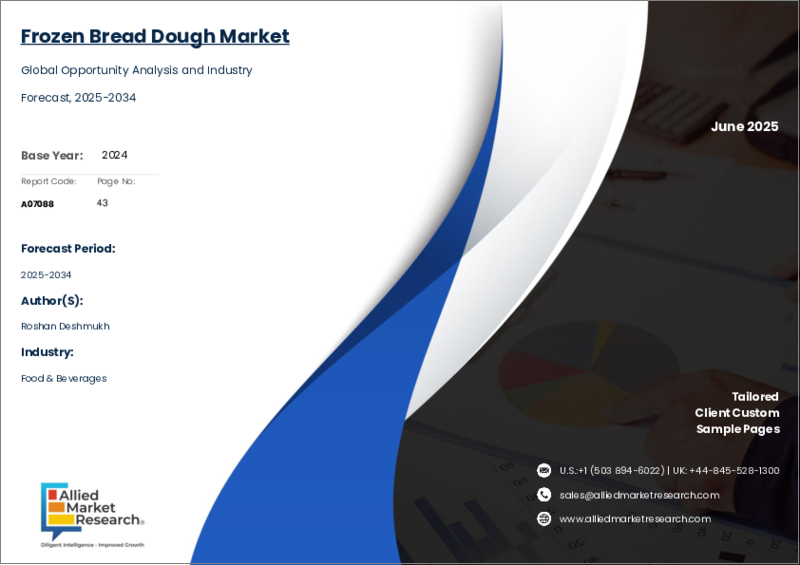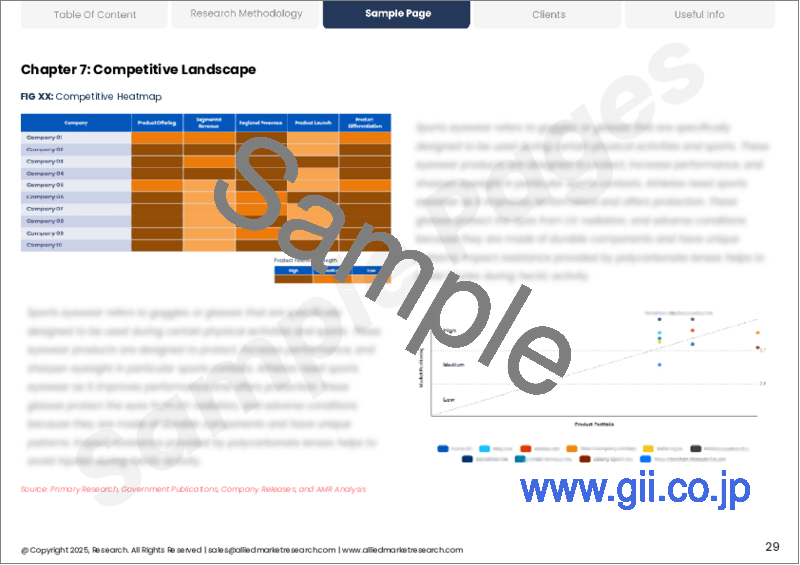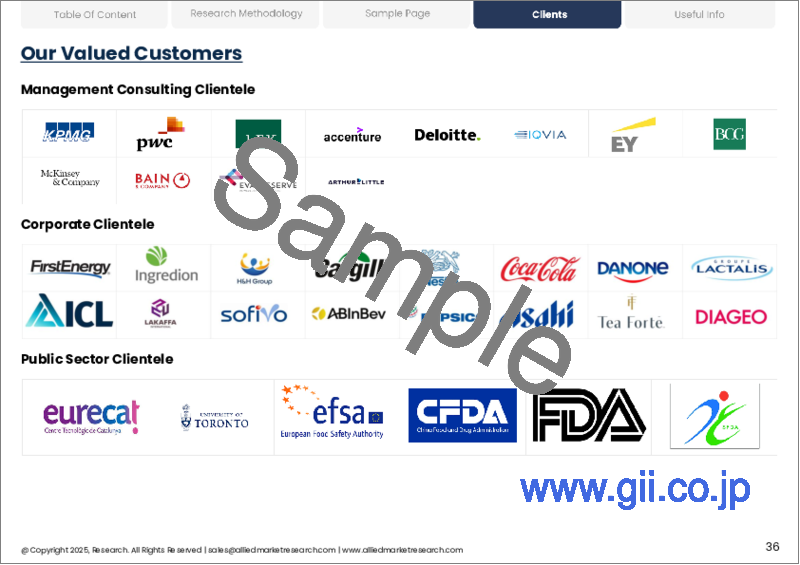|
|
市場調査レポート
商品コード
1645724
冷凍パン生地の世界市場:タイプ別、用途別 - 機会分析と産業予測、2024年~2033年Frozen Bread Dough Market By Type (Conventional, Gluten-free), By Application (Residential, Commericial): Global Opportunity Analysis and Industry Forecast, 2024-2033 |
||||||
|
|||||||
| 冷凍パン生地の世界市場:タイプ別、用途別 - 機会分析と産業予測、2024年~2033年 |
|
出版日: 2024年12月01日
発行: Allied Market Research
ページ情報: 英文 282 Pages
納期: 2~3営業日
|
- 全表示
- 概要
- 目次
冷凍パン生地市場

冷凍パン生地市場は、2023年に7兆3,100億米ドルとなり、2024年から2033年までのCAGRは4.7%を示し、2033年までには11兆5,304億米ドルに達すると推定されます。
冷凍パン生地は小麦粉と液体を混ぜ合わせたもので、パン製造の醗酵・焼成工程の前に冷凍されます。生地は-30℃以下で急速冷凍され、-18℃以下で3ヵ月から6ヵ月間保存できるように準備されます。一からパンを焼く手間を省く、便利なソリューションです。冷凍パン生地は、個人のペースの速いライフスタイルのため、短時間で焼きたての商品を消費することができ、製パン業界で高い支持を得ています。
個人の勤勉なライフスタイルに起因するコンビニエンス・フードの需要の増加は、冷凍パン生地市場の主要な促進要因です。また、冷凍パン生地を使えば、自宅にいながら新鮮な商品をリーズナブルな価格で消費できるため、職人的なパンや特殊なパンの人気の高まりが市場の成長を後押ししています。さらに、食料品や食品を購入するためのeコマース・ウェブサイトの利用が急増していることも、市場開拓を大きく後押ししています。パンの品質を向上させ、工程の効率を高めるために、生地調製に革新的な技術を使用することが現在の動向となっています。例えば、イオン-オゾンキャビテーションと呼ばれる新技術は、イースト添加物の削減または除去を通じて生地の酸度を高めるために脚光を浴びています。
しかし、冷凍食品の健康上の利点や栄養含有量に関する懸念が、冷凍食品の消費を控える多くの個人を引き止めており、冷凍パン生地市場の開拓を妨げています。さらに、厳格な健康安全基準やクリーン・ラベリング基準を遵守することは、高価で時間のかかるプロセスです。これが新規参入を制限し、市場の成長を抑制しています。逆に、レストラン、カフェ、クイックサービス・レストランとの提携や合併は、冷凍パン生地市場に有利な機会をもたらすと予測されています。例えば、QSRマガジン(限定サービス・レストラン・セグメント向けのB2Bマガジン)に掲載された記事によると、クイックサービス・レストランはCOVID-19の流行後、収益性を高めるためにM&Aに大きく関与しています。2024年には、これらのレストランは96億米ドルの大台を超え、2023年から前年比10%増となります。したがって、外食チェーンとのコラボレーションは、冷凍パン生地市場に新たな道を開くことになります。
セグメント別レビュー
冷凍パン生地市場は、タイプ、用途、地域に区分されます。タイプ別では、市場は従来型とグルテンフリーに二分されます。用途別では、住宅用と商業用に分けられます。地域別では、北米、欧州、アジア太平洋、ラテンアメリカ、中東・アフリカで分析されます。
主な調査結果
タイプ別では、従来型セグメントが2023年の市場で高いシェアを占めました。
用途別では、商業用セグメントが2023年の市場で高いシェアを獲得しました。
地域別では、欧州が2023年に最も高い収益を上げました。
利害関係者にとっての主なメリット
当レポートでは、2023年から2033年までの冷凍パン生地市場分析の市場セグメント、現在の動向、推定・動向分析、ダイナミクスを定量的に分析し、一般的な冷凍パン生地市場機会を特定します。
市場促進要因、市場抑制要因、市場機会に関連する情報とともに市場調査を提供します。
ポーターのファイブフォース分析では、利害関係者が利益重視のビジネス決定を下し、サプライヤーとバイヤーのネットワークを強化できるように、バイヤーとサプライヤーの潜在力を強調します。
冷凍パン生地市場のセグメンテーションを詳細に分析することで、市場機会を見極めることができます。
各地域の主要国は、世界市場への収益貢献度に応じてマッピングされています。
市場企業のポジショニングはベンチマーキングを容易にし、市場企業の現在のポジションを明確に理解することができます。
本レポートには、地域別および世界の冷凍パン生地市場動向、主要企業、市場セグメント、応用分野、市場成長戦略の分析が含まれています。
本レポートで可能なレポートカスタマイズ(追加費用とスケジュールがあります。)
- 消費者の購買行動分析
- 製品ライフサイクル
- サプライチェーン分析とベンダーマージン
- 消費者の平均支出
- 消費者の選好と製品仕様
- ペインポイント分析
- 国、地域、世界レベルでの患者/疫学データ
- 規制ガイドライン
- 戦略的提言
- ブランドシェア分析
- クリスクロスセグメント分析-市場規模と予測
- 過去の市場データ
- 輸出入分析/データ
- 主要企業の詳細(所在地、連絡先、サプライヤー/ベンダーネットワークなどを含む、エクセル形式)
- 顧客/消費者/原料サプライヤーのリスト-バリューチェーン分析
- 世界/地域/国別レベルでのプレーヤーの市場シェア分析
- 一人当たり消費動向
- SWOT分析
- 数量市場規模と予測
目次
第1章 イントロダクション
第2章 エグゼクティブサマリー
第3章 市場概要
- 市場の定義と範囲
- 主要な調査結果
- 主要な影響要因
- 主要な投資機会
- ポーターのファイブフォース分析
- 市場力学
- 促進要因
- 外食産業の成長
- 調理済み製品に対する需要の増加
- 世界の世界化と料理動向
- 抑制要因
- 鮮度に対する認識
- 保管・輸送コスト
- 機会
- ホームベーカリーや趣味人の利便性
- フードサービス業者との戦略的パートナーシップ
- 促進要因
- バリューチェーン分析
- メーカー詳細:国別
第4章 冷凍パン生地市場:タイプ別
- 概要
- 従来型
- グルテンフリー
第5章 冷凍パン生地市場:用途別
- 概要
- 住宅用
- 商業用
第6章 冷凍パン生地市場:地域別
- 概要
- 北米
- 米国
- カナダ
- メキシコ
- 欧州
- フランス
- ドイツ
- イタリア
- スペイン
- 英国
- その他
- アジア太平洋
- 中国
- 日本
- インド
- 韓国
- オーストラリア
- その他
- ラテンアメリカ、中東・アフリカ
- ブラジル
- 南アフリカ
- サウジアラビア
- アルゼンチン
- その他
第7章 競合情勢
- イントロダクション
- 主要成功戦略
- 主要10社の製品マッピング
- 競合ダッシュボード
- 競合ヒートマップ
- 主要企業のポジショニング、2023年
第8章 企業プロファイル
- ARYZTA AG
- Lantmannen Unibake
- Associated British Foods PLC
- General Mills, Inc.
- EUROPASTRY S.A.
- J&J Snack Foods Corp.
- Gonnella Baking Company
- La Rose Noire
- George Weston Limited
- Bridgford Foods Corporation
- Dawn Food Products Inc.
- NamChow
- Campbell Soup Company
- Flower Foods Inc.
- Aokun Food
- Jiangxi Xinwanlai Food Co., Ltd.
- EDNA International GmbH
- groupe le duff
- Guttenplan's
- Rich Products Corporation
- Rhodes
- Grupo Bimbo
- Cerelia
Frozen Bread Dough Market

The frozen bread dough market was valued at $7,310.00 billion in 2023 and is estimated to reach $11,530.40 billion by 2033, exhibiting a CAGR of 4.7% from 2024 to 2033.
Frozen bread dough is a regular mix of flour and liquid that undergoes freezing before the proofing and baking processes of bread making. The dough undergoes a quick freeze at temperatures below -30°C, preparing it to be stored at below -18°C for 3-6 months. It serves as a convenient solution for individuals to bake bread without undergoing the hassle of beginning from scratch. Frozen bread dough is witnessing high traction in the baking industry due to the fast-paced lifestyles of individuals, allowing them to consume freshly baked goods in short durations.
Rise in demand for convenience foods due to the diligent lifestyles of individuals is a key driver of the frozen bread dough market. In addition, increase in the popularity of artisanal and specialty breads has propelled the growth of the market as frozen doughs allow individuals to consume fresh goods at reasonable prices from the comfort of their homes. Furthermore, upsurge in the use of e-commerce websites for the purchase of groceries and eatables augments the market development significantly. To improve the quality of bread and enhance the efficiency of the process, the use of innovative technologies for dough preparation is currently trending. For instance, a novel technology called ion-ozone cavitation is gaining prominence for increasing the acidity of the dough through the reduction or elimination of yeast additives.
However, concerns regarding the health benefits and nutritional content of frozen eatables deter a large base of individuals from consuming them, hampering the development of the frozen bread dough market. Moreover, compliance with the stringent health safety and clean labeling standards is an expensive & time-consuming process. This limits the entry of new players and restrains the market growth. On the contrary, collaborations or mergers with restaurants, cafes, and quick-service restaurants are projected to present lucrative opportunities for the frozen bread dough market. For instance, an article published in the QSR magazine-a B2B magazine for the limited-service restaurant segment-states that quick-service restaurants have significantly been involved in mergers & acquisitions post the COVID-19 pandemic to grow their profitability. In 2024, these restaurants have crossed the mark of $9.6 billion, which is a 10% year-over-year increase from 2023. Therefore, collaboration with food service chains is poised to open new avenues for the frozen bread dough market.
Segment Review
The frozen bread dough market is segmented into type, application, and region. By type, the market is bifurcated into conventional and gluten-free. Depending on application, it is divided into residential and commercial. Region wise, it is analyzed across North America, Europe, Asia-Pacific, and LAMEA.
Key Findings
By type, the conventional segment held a high share of the market in 2023.
Depending on application, the commercial segment acquired a high stake in the market in 2023.
Region wise, Europe was the highest revenue generator in 2023.
Competition Analysis
The leading players operating in the frozen bread dough market are J&J Snack Foods Corp., Aryazta AG, Associated British Foods PLC, General Mills Inc., George Weston Limited, Bridgford Foods, Dawn Food Products Inc., Campbell Soup Company, The Cerelia Group, and Grupo Bimbo. These major players have adopted various key development strategies such as mergers, product launches, acquisitions, collaborations, and partnerships to strengthen their foothold in the competitive market.
Key Benefits for Stakeholders
This report provides a quantitative analysis of the market segments, current trends, estimations, and dynamics of the frozen bread dough market analysis from 2023 to 2033 to identify the prevailing frozen bread dough market opportunities.
The market research is offered along with information related to key drivers, restraints, and opportunities.
Porter's five forces analysis highlights the potency of buyers and suppliers to enable stakeholders make profit-oriented business decisions and strengthen their supplier-buyer network.
In-depth analysis of the frozen bread dough market segmentation assists to determine the prevailing market opportunities.
Major countries in each region are mapped according to their revenue contribution to the global market.
Market player positioning facilitates benchmarking and provides a clear understanding of the present position of the market players.
The report includes the analysis of the regional as well as global frozen bread dough market trends, key players, market segments, application areas, and market growth strategies.
Additional benefits you will get with this purchase are:
- Quarterly Update and* (only available with a corporate license, on listed price)
- 5 additional Company Profile of client Choice pre- or Post-purchase, as a free update.
- Free Upcoming Version on the Purchase of Five and Enterprise User License.
- 16 analyst hours of support* (post-purchase, if you find additional data requirements upon review of the report, you may receive support amounting to 16 analyst hours to solve questions, and post-sale queries)
- 15% Free Customization* (in case the scope or segment of the report does not match your requirements, 15% is equivalent to 3 working days of free work, applicable once)
- Free data Pack on the Five and Enterprise User License. (Excel version of the report)
- Free Updated report if the report is 6-12 months old or older.
- 24-hour priority response*
- Free Industry updates and white papers.
Possible Customization with this report (with additional cost and timeline, please talk to the sales executive to know more)
- Consumer Buying Behavior Analysis
- Product Life Cycles
- Supply Chain Analysis & Vendor Margins
- Average Consumer Expenditure
- Consumer Preference and Product Specifications
- Pain Point Analysis
- Patient/epidemiology data at country, region, global level
- Regulatory Guidelines
- Strategic Recommedations
- Brands Share Analysis
- Criss-cross segment analysis- market size and forecast
- Historic market data
- Import Export Analysis/Data
- Key player details (including location, contact details, supplier/vendor network etc. in excel format)
- List of customers/consumers/raw material suppliers- value chain analysis
- Market share analysis of players at global/region/country level
- Per Capita Consumption Trends
- SWOT Analysis
- Volume Market Size and Forecast
Key Market Segments
By Type
- Conventional
- Gluten-free
By Application
- Residential
- Commericial
By Region
- North America
- U.S.
- Canada
- Mexico
- Europe
- France
- Germany
- Italy
- Spain
- UK
- Rest of Europe
- Asia-Pacific
- China
- Japan
- India
- South Korea
- Australia
- Rest of Asia-Pacific
- LAMEA
- Brazil
- South Africa,
- Saudi Arabia
- Argentina
- Rest of LAMEA
Key Market Players:
- Guttenplan's
- EDNA International GmbH
- groupe le duff
- Gonnella Baking Company
- Flower Foods Inc.
- General Mills, Inc.
- EUROPASTRY S.A.
- Aokun Food
- Campbell Soup Company
- Lantmannen Unibake
- J&J Snack Foods Corp.
- ARYZTA AG
- Associated British Foods PLC
- George Weston Limited
- Dawn Food Products Inc.
- Rhodes
- Cerelia
- NamChow
- La Rose Noire
- Bridgford Foods Corporation
- Jiangxi Xinwanlai Food Co., Ltd.
- Rich Products Corporation
- Grupo Bimbo
TABLE OF CONTENTS
CHAPTER 1: INTRODUCTION
- 1.1. Report description
- 1.2. Key market segments
- 1.3. Key benefits to the stakeholders
- 1.4. Research methodology
- 1.4.1. Primary research
- 1.4.2. Secondary research
- 1.4.3. Analyst tools and models
CHAPTER 2: EXECUTIVE SUMMARY
- 2.1. CXO perspective
CHAPTER 3: MARKET OVERVIEW
- 3.1. Market definition and scope
- 3.2. Key findings
- 3.2.1. Top impacting factors
- 3.2.2. Top investment pockets
- 3.3. Porter's five forces analysis
- 3.3.1. Low bargaining power of suppliers
- 3.3.2. Low threat of new entrants
- 3.3.3. Moderate threat of substitutes
- 3.3.4. Low intensity of rivalry
- 3.3.5. Moderate bargaining power of buyers
- 3.4. Market dynamics
- 3.4.1. Drivers
- 3.4.1.1. Growth in Food Service Industry
- 3.4.1.2. Increase in Demand for Ready-to-Bake Products
- 3.4.1.3. Globalization and Culinary Trends
- 3.4.2. Restraints
- 3.4.2.1. Perception of Freshness
- 3.4.2.2. Storage and Transportation Costs
- 3.4.3. Opportunities
- 3.4.3.1. Convenience for Home Bakers and Hobbyists
- 3.4.3.2. Strategic Partnerships with Food Service Providers
- 3.4.1. Drivers
- 3.5. Value Chain Analysis
- 3.6. Details of Manufacturers, By Country
CHAPTER 4: FROZEN BREAD DOUGH MARKET, BY TYPE
- 4.1. Overview
- 4.1.1. Market size and forecast
- 4.2. Conventional
- 4.2.1. Key market trends, growth factors and opportunities
- 4.2.2. Market size and forecast, by region
- 4.2.3. Market share analysis by country
- 4.3. Gluten-free
- 4.3.1. Key market trends, growth factors and opportunities
- 4.3.2. Market size and forecast, by region
- 4.3.3. Market share analysis by country
CHAPTER 5: FROZEN BREAD DOUGH MARKET, BY APPLICATION
- 5.1. Overview
- 5.1.1. Market size and forecast
- 5.2. Residential
- 5.2.1. Key market trends, growth factors and opportunities
- 5.2.2. Market size and forecast, by region
- 5.2.3. Market share analysis by country
- 5.3. Commericial
- 5.3.1. Key market trends, growth factors and opportunities
- 5.3.2. Market size and forecast, by region
- 5.3.3. Market share analysis by country
CHAPTER 6: FROZEN BREAD DOUGH MARKET, BY REGION
- 6.1. Overview
- 6.1.1. Market size and forecast By Region
- 6.2. North America
- 6.2.1. Key market trends, growth factors and opportunities
- 6.2.2. Market size and forecast, by Type
- 6.2.3. Market size and forecast, by Application
- 6.2.4. Market size and forecast, by country
- 6.2.4.1. U.S.
- 6.2.4.1.1. Market size and forecast, by Type
- 6.2.4.1.2. Market size and forecast, by Application
- 6.2.4.2. Canada
- 6.2.4.2.1. Market size and forecast, by Type
- 6.2.4.2.2. Market size and forecast, by Application
- 6.2.4.3. Mexico
- 6.2.4.3.1. Market size and forecast, by Type
- 6.2.4.3.2. Market size and forecast, by Application
- 6.3. Europe
- 6.3.1. Key market trends, growth factors and opportunities
- 6.3.2. Market size and forecast, by Type
- 6.3.3. Market size and forecast, by Application
- 6.3.4. Market size and forecast, by country
- 6.3.4.1. France
- 6.3.4.1.1. Market size and forecast, by Type
- 6.3.4.1.2. Market size and forecast, by Application
- 6.3.4.2. Germany
- 6.3.4.2.1. Market size and forecast, by Type
- 6.3.4.2.2. Market size and forecast, by Application
- 6.3.4.3. Italy
- 6.3.4.3.1. Market size and forecast, by Type
- 6.3.4.3.2. Market size and forecast, by Application
- 6.3.4.4. Spain
- 6.3.4.4.1. Market size and forecast, by Type
- 6.3.4.4.2. Market size and forecast, by Application
- 6.3.4.5. UK
- 6.3.4.5.1. Market size and forecast, by Type
- 6.3.4.5.2. Market size and forecast, by Application
- 6.3.4.6. Rest of Europe
- 6.3.4.6.1. Market size and forecast, by Type
- 6.3.4.6.2. Market size and forecast, by Application
- 6.4. Asia-Pacific
- 6.4.1. Key market trends, growth factors and opportunities
- 6.4.2. Market size and forecast, by Type
- 6.4.3. Market size and forecast, by Application
- 6.4.4. Market size and forecast, by country
- 6.4.4.1. China
- 6.4.4.1.1. Market size and forecast, by Type
- 6.4.4.1.2. Market size and forecast, by Application
- 6.4.4.2. Japan
- 6.4.4.2.1. Market size and forecast, by Type
- 6.4.4.2.2. Market size and forecast, by Application
- 6.4.4.3. India
- 6.4.4.3.1. Market size and forecast, by Type
- 6.4.4.3.2. Market size and forecast, by Application
- 6.4.4.4. South Korea
- 6.4.4.4.1. Market size and forecast, by Type
- 6.4.4.4.2. Market size and forecast, by Application
- 6.4.4.5. Australia
- 6.4.4.5.1. Market size and forecast, by Type
- 6.4.4.5.2. Market size and forecast, by Application
- 6.4.4.6. Rest of Asia-Pacific
- 6.4.4.6.1. Market size and forecast, by Type
- 6.4.4.6.2. Market size and forecast, by Application
- 6.5. LAMEA
- 6.5.1. Key market trends, growth factors and opportunities
- 6.5.2. Market size and forecast, by Type
- 6.5.3. Market size and forecast, by Application
- 6.5.4. Market size and forecast, by country
- 6.5.4.1. Brazil
- 6.5.4.1.1. Market size and forecast, by Type
- 6.5.4.1.2. Market size and forecast, by Application
- 6.5.4.2. South Africa,
- 6.5.4.2.1. Market size and forecast, by Type
- 6.5.4.2.2. Market size and forecast, by Application
- 6.5.4.3. Saudi Arabia
- 6.5.4.3.1. Market size and forecast, by Type
- 6.5.4.3.2. Market size and forecast, by Application
- 6.5.4.4. Argentina
- 6.5.4.4.1. Market size and forecast, by Type
- 6.5.4.4.2. Market size and forecast, by Application
- 6.5.4.5. Rest of LAMEA
- 6.5.4.5.1. Market size and forecast, by Type
- 6.5.4.5.2. Market size and forecast, by Application
CHAPTER 7: COMPETITIVE LANDSCAPE
- 7.1. Introduction
- 7.2. Top winning strategies
- 7.3. Product mapping of top 10 player
- 7.4. Competitive dashboard
- 7.5. Competitive heatmap
- 7.6. Top player positioning, 2023
CHAPTER 8: COMPANY PROFILES
- 8.1. ARYZTA AG
- 8.1.1. Company overview
- 8.1.2. Key executives
- 8.1.3. Company snapshot
- 8.1.4. Operating business segments
- 8.1.5. Product portfolio
- 8.1.6. Business performance
- 8.1.7. Key strategic moves and developments
- 8.2. Lantmannen Unibake
- 8.2.1. Company overview
- 8.2.2. Key executives
- 8.2.3. Company snapshot
- 8.2.4. Operating business segments
- 8.2.5. Product portfolio
- 8.2.6. Business performance
- 8.2.7. Key strategic moves and developments
- 8.3. Associated British Foods PLC
- 8.3.1. Company overview
- 8.3.2. Key executives
- 8.3.3. Company snapshot
- 8.3.4. Operating business segments
- 8.3.5. Product portfolio
- 8.3.6. Business performance
- 8.4. General Mills, Inc.
- 8.4.1. Company overview
- 8.4.2. Key executives
- 8.4.3. Company snapshot
- 8.4.4. Operating business segments
- 8.4.5. Product portfolio
- 8.4.6. Business performance
- 8.5. EUROPASTRY S.A.
- 8.5.1. Company overview
- 8.5.2. Key executives
- 8.5.3. Company snapshot
- 8.5.4. Operating business segments
- 8.5.5. Product portfolio
- 8.5.6. Business performance
- 8.5.7. Key strategic moves and developments
- 8.6. J&J Snack Foods Corp.
- 8.6.1. Company overview
- 8.6.2. Key executives
- 8.6.3. Company snapshot
- 8.6.4. Operating business segments
- 8.6.5. Product portfolio
- 8.6.6. Business performance
- 8.7. Gonnella Baking Company
- 8.7.1. Company overview
- 8.7.2. Key executives
- 8.7.3. Company snapshot
- 8.7.4. Operating business segments
- 8.7.5. Product portfolio
- 8.8. La Rose Noire
- 8.8.1. Company overview
- 8.8.2. Key executives
- 8.8.3. Company snapshot
- 8.8.4. Operating business segments
- 8.8.5. Product portfolio
- 8.9. George Weston Limited
- 8.9.1. Company overview
- 8.9.2. Key executives
- 8.9.3. Company snapshot
- 8.9.4. Operating business segments
- 8.9.5. Product portfolio
- 8.9.6. Business performance
- 8.10. Bridgford Foods Corporation
- 8.10.1. Company overview
- 8.10.2. Key executives
- 8.10.3. Company snapshot
- 8.10.4. Operating business segments
- 8.10.5. Product portfolio
- 8.10.6. Business performance
- 8.11. Dawn Food Products Inc.
- 8.11.1. Company overview
- 8.11.2. Key executives
- 8.11.3. Company snapshot
- 8.11.4. Operating business segments
- 8.11.5. Product portfolio
- 8.12. NamChow
- 8.12.1. Company overview
- 8.12.2. Key executives
- 8.12.3. Company snapshot
- 8.12.4. Operating business segments
- 8.12.5. Product portfolio
- 8.12.6. Business performance
- 8.13. Campbell Soup Company
- 8.13.1. Company overview
- 8.13.2. Key executives
- 8.13.3. Company snapshot
- 8.13.4. Operating business segments
- 8.13.5. Product portfolio
- 8.13.6. Business performance
- 8.14. Flower Foods Inc.
- 8.14.1. Company overview
- 8.14.2. Key executives
- 8.14.3. Company snapshot
- 8.14.4. Operating business segments
- 8.14.5. Product portfolio
- 8.14.6. Business performance
- 8.14.7. Key strategic moves and developments
- 8.15. Aokun Food
- 8.15.1. Company overview
- 8.15.2. Key executives
- 8.15.3. Company snapshot
- 8.15.4. Operating business segments
- 8.15.5. Product portfolio
- 8.16. Jiangxi Xinwanlai Food Co., Ltd.
- 8.16.1. Company overview
- 8.16.2. Key executives
- 8.16.3. Company snapshot
- 8.16.4. Operating business segments
- 8.16.5. Product portfolio
- 8.17. EDNA International GmbH
- 8.17.1. Company overview
- 8.17.2. Key executives
- 8.17.3. Company snapshot
- 8.17.4. Operating business segments
- 8.17.5. Product portfolio
- 8.18. groupe le duff
- 8.18.1. Company overview
- 8.18.2. Key executives
- 8.18.3. Company snapshot
- 8.18.4. Operating business segments
- 8.18.5. Product portfolio
- 8.18.6. Key strategic moves and developments
- 8.19. Guttenplan's
- 8.19.1. Company overview
- 8.19.2. Key executives
- 8.19.3. Company snapshot
- 8.19.4. Operating business segments
- 8.19.5. Product portfolio
- 8.20. Rich Products Corporation
- 8.20.1. Company overview
- 8.20.2. Key executives
- 8.20.3. Company snapshot
- 8.20.4. Operating business segments
- 8.20.5. Product portfolio
- 8.21. Rhodes
- 8.21.1. Company overview
- 8.21.2. Key executives
- 8.21.3. Company snapshot
- 8.21.4. Operating business segments
- 8.21.5. Product portfolio
- 8.22. Grupo Bimbo
- 8.22.1. Company overview
- 8.22.2. Key executives
- 8.22.3. Company snapshot
- 8.22.4. Operating business segments
- 8.22.5. Product portfolio
- 8.22.6. Business performance
- 8.23. Cerelia
- 8.23.1. Company overview
- 8.23.2. Key executives
- 8.23.3. Company snapshot
- 8.23.4. Operating business segments
- 8.23.5. Product portfolio






